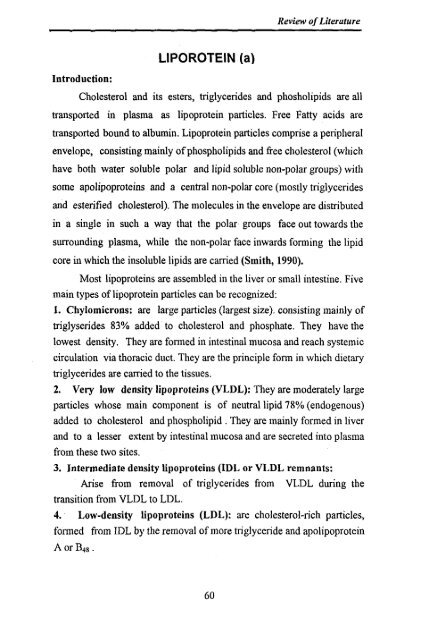J.'.~"";i'
J.'.~"";i' J.'.~"";i'
Introduction: L1POROTEIN (a) Review ofLiterature Cholesterol and its esters, triglycerides and phosholipids are all transported in plasma as lipoprotein particles. Free Fatty acids are transported bound to albumin. Lipoprotein particles comprise a peripheral envelope, consisting mainly ofphospholipids and free cholesterol (which have both water soluble polar and lipid soluble non-polar groups) with some apolipoproteins and a central non-polar core (mostly triglycerides and esterified cholesterol). The molecules in the envelope are distributed in a single in such a way that the polar groups face out towards the surrounding plasma, while the non-polar face inwards forming the lipid core in which the insoluble lipids are carried (Smith, 1990). Most lipoproteins are assembled in the liver or small intestine. Five main types oflipoprotein particles can be recognized: 1. Chylomicrons: are large particles (largest size). consisting mainly of triglyserides 83% added to cholesterol and phosphate. They have the lowest density. They are formed in intestinal mucosa and reach systemic circulation via thoracic duct. They are the principle form in which dietary triglycerides are carried to the tissues. 2. Very low density lipoproteins (YLDL): They are moderately large particles whose main component is of neutral lipid 78% (endogenous) added to cholesterol and phospholipid. They are mainly formed in liver and to a lesser extent by intestinal mucosa and are secreted into plasma from these two sites. 3. Intermediate density lipoproteins (IDL or VLDL remnants: Arise from removal of triglycerides from VLDL during the transition from VLDLto LDL. 4. Low-density lipoproteins (LDL): are cholesterol-rich particles, formed from IDL by the removal of more triglyceride and apolipoprotein A orB48 . 60 ''1 .....
- Page 18 and 19: Pathogenesis of pre- eclampsia Revi
- Page 20 and 21: -.-- Review ofLiterature Changes in
- Page 22 and 23: --f' -,- Review ofLiterature clinic
- Page 24 and 25: Review ofLiterature and is consider
- Page 27 and 28: Review ofLiterature next pregnancy
- Page 29 and 30: Review ofLiterature On the other ha
- Page 31 and 32: Review ofLiterature which is define
- Page 34 and 35: 1. Gestational hypertension (withou
- Page 36: Review ofLiterature However, severe
- Page 40 and 41: Review ofLiterature It is an indica
- Page 42: Review ofLiterature above hemodynam
- Page 45: Review ofLiterature patients (Nahee
- Page 49: Proteinuria and microalbuminuria :
- Page 55: Review ofLiterature peptides includ
- Page 58 and 59: .... -,:-" Review ofLiterature a. T
- Page 60 and 61: .... 'I, - 2. Occular complications
- Page 62 and 63: ,- - 6. HELLP syndrome: ReviewofLit
- Page 64 and 65: II. Maternal mortality: Review ofLi
- Page 66: Review ofLiterature Management of p
- Page 71: Review ofLiterature carbohydrate co
- Page 74 and 75: t- Review ofLiterature Table (3) Ch
- Page 76 and 77: +- L" , .- Review ofLiterature incr
- Page 78 and 79: III. Lp (a) ill P.LH: Review ofLite
- Page 80 and 81: PATIENTS AND METHODS
- Page 85: .. Procedure: Patients and Methods
- Page 90 and 91: (Table 10) Reagents: Reagent 1 Phos
- Page 96 and 97: Kruskal wallis test: Statistical An
- Page 98 and 99: Results Results This work was condu
- Page 100 and 101: .;. Results Table (14) Shows bioche
- Page 103: Results and severe PIR (p
- Page 106 and 107: Control Mild PIH Severe group PIH I
- Page 108 and 109: Control Mild PlH Severe group PIH R
- Page 111: Discussion Staff et al . (1999) sug
- Page 114 and 115: ."1:. SUMMARY AND CONCLUSION
- Page 116: Summary and Conclusions LP(a), is a
Introduction:<br />
L1POROTEIN (a)<br />
Review ofLiterature<br />
Cholesterol and its esters, triglycerides and phosholipids are all<br />
transported in plasma as lipoprotein particles. Free Fatty acids are<br />
transported bound to albumin. Lipoprotein particles comprise a peripheral<br />
envelope, consisting mainly ofphospholipids and free cholesterol (which<br />
have both water soluble polar and lipid soluble non-polar groups) with<br />
some apolipoproteins and a central non-polar core (mostly triglycerides<br />
and esterified cholesterol). The molecules in the envelope are distributed<br />
in a single in such a way that the polar groups face out towards the<br />
surrounding plasma, while the non-polar face inwards forming the lipid<br />
core in which the insoluble lipids are carried (Smith, 1990).<br />
Most lipoproteins are assembled in the liver or small intestine. Five<br />
main types oflipoprotein particles can be recognized:<br />
1. Chylomicrons: are large particles (largest size). consisting mainly of<br />
triglyserides 83% added to cholesterol and phosphate. They have the<br />
lowest density. They are formed in intestinal mucosa and reach systemic<br />
circulation via thoracic duct. They are the principle form in which dietary<br />
triglycerides are carried to the tissues.<br />
2. Very low density lipoproteins (YLDL): They are moderately large<br />
particles whose main component is of neutral lipid 78% (endogenous)<br />
added to cholesterol and phospholipid. They are mainly formed in liver<br />
and to a lesser extent by intestinal mucosa and are secreted into plasma<br />
from these two sites.<br />
3. Intermediate density lipoproteins (IDL or VLDL remnants:<br />
Arise from removal of triglycerides from VLDL during the<br />
transition from VLDLto LDL.<br />
4. Low-density lipoproteins (LDL): are cholesterol-rich particles,<br />
formed from IDL by the removal of more triglyceride and apolipoprotein<br />
A orB48 .<br />
60<br />
''1<br />
.....



